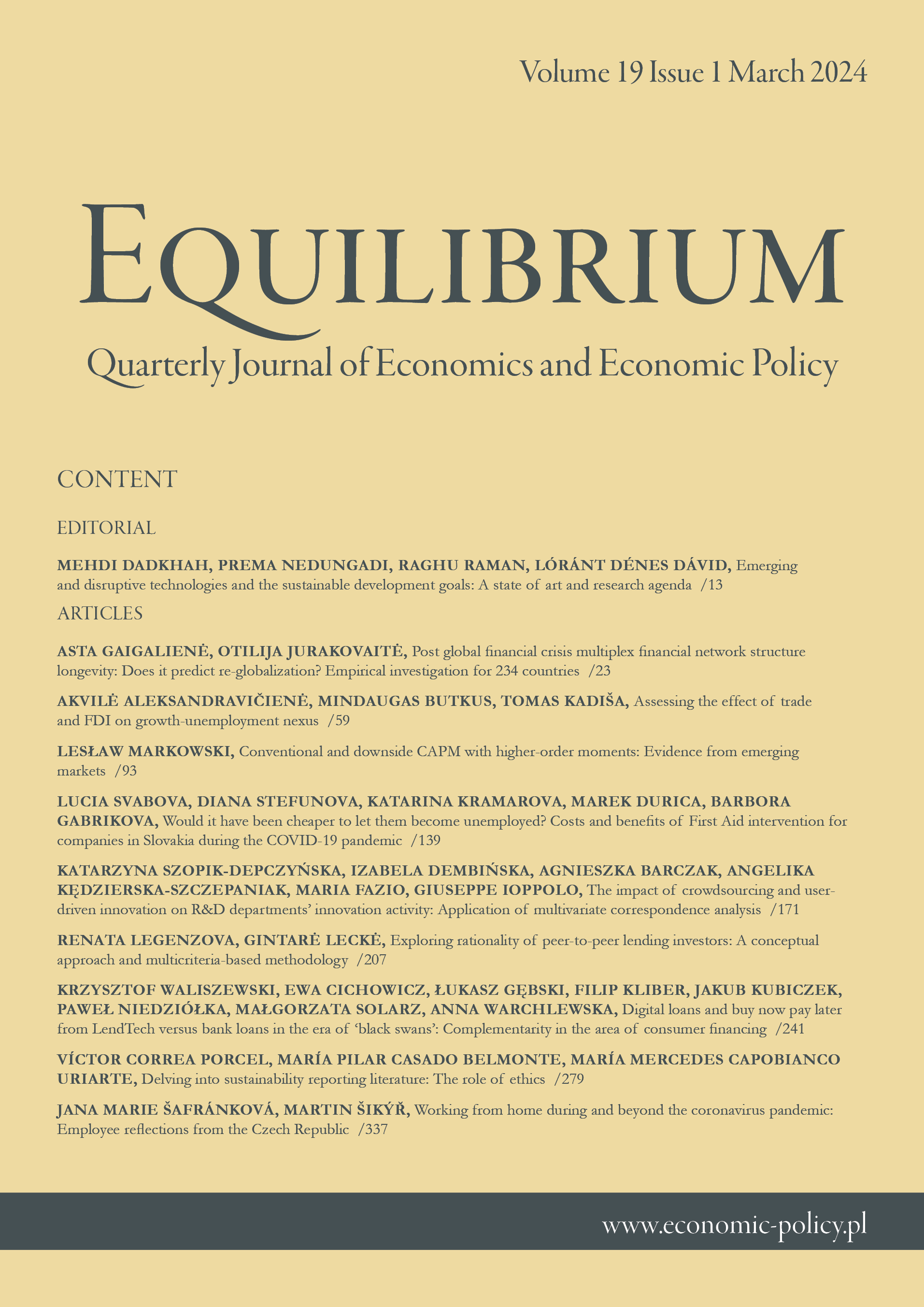Asymmetry and convergence in the development of digital technologies in the EU countries
IF 6.2
Q1 ECONOMICS
Equilibrium-Quarterly Journal of Economics and Economic Policy
Pub Date : 2023-09-30
DOI:10.24136/eq.2023.022
引用次数: 0
Abstract
Research background: Digitalization in the context of the COVID-19 pandemic has accelerated significantly across Europe, including in regions that are at the stage of catch-up development. However, as innovative technologies are intensively integrated into everyday life, the digital gap between the EU countries is increasing. The widening digital gap is becoming a serious threat to achieving the EU's sustainable development goals and building a sustainable European society. Purpose of the article: The purpose of the article was to empirically substantiate the inclusiveness and convergence of the digital strategy in the EU countries. Methods: Using the method of fuzzy sets, the level of asymmetry in access to transactional (e-commerce), information (cloud computing), operational (artificial intelligence) technologies in the EU countries was assessed. The negative impact of the digital gap within the countries (the gap between small, medium, large companies) and the global digital gap (the gap between EU countries) on the competitiveness of countries was established, for which correlation analysis and the Granger causality test were used. Findings & value added: The findings of this study contribute to the literature of digital transformation and digital gap of European countries. The impact of the digital gap in transactional, information, operational technologies on the competitiveness of countries is differentiated depending on the level of digitalization of the country. Cluster groups of countries are determined by the convergence of digitalization and ways to ensure long-term competitiveness. The directions for reducing the digital gap in the EU countries are substantiated by changing the priorities of spending on innovation and increasing productivity, diversifying the digital technologies used. The empirical results obtained can serve as a basis for improving the effectiveness of the digitalization policy in the EU countries in accordance with individual convergence goals. The main added value of the paper is related to the presented research procedure, which can be used in analyses of digital technologies development also for other countries. The results provide valuable insights into evaluating the digital technologies in European countries.欧盟国家数字技术发展的不对称与趋同
研究背景:在2019冠状病毒病大流行背景下,数字化在整个欧洲显著加快,包括在处于追赶发展阶段的地区。然而,随着创新技术深入融入日常生活,欧盟国家之间的数字差距正在扩大。不断扩大的数字鸿沟正在成为实现欧盟可持续发展目标和建设可持续欧洲社会的严重威胁。文章的目的:文章的目的是实证证实欧盟国家数字战略的包容性和收敛性。方法:采用模糊集方法,对欧盟国家在获取交易(电子商务)、信息(云计算)、运营(人工智能)技术方面的不对称程度进行评估。建立了国家内部数字差距(大、中、小企业之间的差距)和全球数字差距(欧盟国家之间的差距)对国家竞争力的负面影响,并使用相关分析和格兰杰因果检验。的发现,附加值:本研究的发现有助于欧洲国家数字化转型与数字化差距的文献研究。交易技术、信息技术、业务技术方面的数字化差距对国家竞争力的影响因国家数字化水平的不同而有差异。国家集群群是由数字化的融合和确保长期竞争力的方法决定的。减少欧盟国家数字差距的方向是通过改变创新支出的优先事项和提高生产力,使所使用的数字技术多样化来证实的。所得实证结果可作为欧盟各国根据各自的趋同目标提高数字化政策有效性的基础。本文的主要附加值与所提出的研究过程有关,可以用于分析其他国家的数字技术发展。研究结果为评估欧洲国家的数字技术提供了有价值的见解。
本文章由计算机程序翻译,如有差异,请以英文原文为准。
求助全文
约1分钟内获得全文
求助全文
来源期刊
CiteScore
9.20
自引率
3.50%
发文量
28
审稿时长
36 weeks
期刊介绍:
Equilibrium. Quarterly Journal of Economics and Economic Policy is a scientific journal dedicated to economics, which is the result of close cooperation between the Instytut Badań Gospodarczych/Institute of Economic Research (Poland) and Polish Economic Society and leading European universities. The journal constitutes a platform for exchange of views of the scientific community, as well as reflects the current status and trends of world science and economy.
The journal especially welcome empirical articles making use of quantitative methods in: Macroeconomics and Monetary Economics, International Economics, Financial Economics and Banking, Public Economics, Business Economics, Labor and Demographic Economics, Economic Development, and Technological Change, and Growth.
Current most preferable topics and special issues:
The economics of artificial intelligence: business potentials and risks;
Digitalization and entrepreneurship in economics;
Sustainable socio-economic development, environmental and ecological economics;
Transition in the energy market (improving energy efficiency, alternative energy sources, renewable energy, energy security).

 求助内容:
求助内容: 应助结果提醒方式:
应助结果提醒方式:


